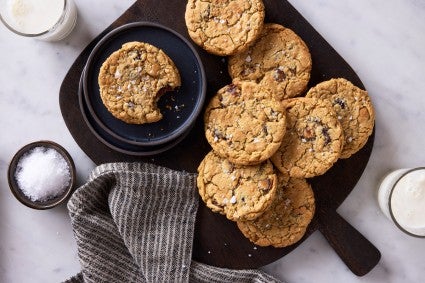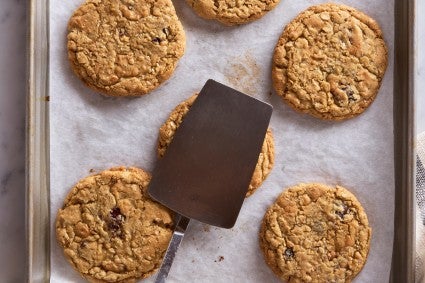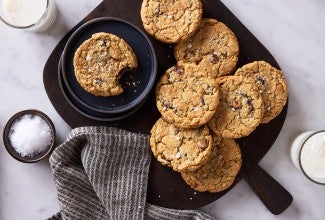Why you should start smashing your cookies
A trick for cookies with crisp edges and soft centers.


Smash burgers have been all the rage for a few years now, but you know what might be even better? Smash cookies.
Thank star baker Zoë Francois for the inspiration. In her latest cookbook, Zoë Bakes Cookies, she includes a recipe for “Smash Cookies,” which are flattened with a spatula at the end of baking, resulting in a thick, dense cookie with a crispy crust.
The stroke of innovation, however, was a bit of an accident. It started with an attempt to replicate Levain Bakery’s famous chocolate chip cookies — massive, puck-like cookies with crispy, browned exteriors and molten, doughy centers. But while testing her version, “I just wasn't madly in love with the results when they were so big straight from the oven, even though that's originally what I was trying for,” Zoë recalls. “In a fit of inspiration, to salvage the batch, I grabbed a spatula and smashed them. The result was a cookie that had a better ratio of toasty edges and a gooey center.” The smash cookie was born.
It’s a technique that caught the eye of King Arthur’s Test Kitchen Director Sarah Jampel, who knew immediately that she had to try it out. “I thought the technique was so fun!” she says. “And I was eager to apply it to a cookie where I wanted the inside to stay soft and gooey.” The result, after much testing, was these super-sized Oatmeal-Date Smash Cookies (which have quickly become a cult favorite around the King Arthur office, including for yours truly).

In this recipe, Sarah expands on Zoë’s initial technique and smashes the cookies not once, but twice. The first smash happens toward the end of baking, when the extra-large cookies have puffed dramatically in the oven. But then, after being flattened with the back of a spatula, the cookies are returned to the turned-off oven for an extra five minutes. The residual heat helps the cookies bake all the way through, during which time they puff again slightly. Once removed, they get smashed flat with a spatula a second and final time. The result? Cookies with a dense, fudgy interior and a crackly crust. “I think it's a great method to play around with if you're a texture-seeker, eager for cookies with crisp edges and sturdy bottoms but soft, bendy centers,” says Sarah.
Zoë notes in her cookbook that the size of the cookies matter — make them smaller, and they won’t achieve the right texture. As Sarah explains, “The bigger the cookie, the more contrast you'll get, because more of the cookie is going to stay insulated from the heat, and therefore soft, as the dough balls bake.” A smaller cookie, meanwhile, would bake too quickly, and therefore lose its soft texture. (And also, who doesn't love a giant cookie?!) Zoë also says that “making sure the dough is super well chilled is key, and the longer you let the dough balls sit in the refrigerator, the more dramatic the smash.”

Happily, this technique can be used in other drop cookies, as long as they’re large — aim for around 80 grams of dough, or roughly 2" balls. (A level scone and muffin scoop works well here.) I recently baked Sugar Cookies using the smash technique resulting in crispy-yet-chewy cookies that retained their soft interiors. Next up, I'm going to try this technique on my favorite chocolate chip cookies.
One final note: according to Zoë, your flour choice can make a difference. “The protein content in King Arthur’s All-Purpose Flour (11.7%) is perfect for these cookies, as it helps keep their shape when baking,” she recommends.
Cover photo by Patrick Marinello; food styling by Kaitlin Wayne.


